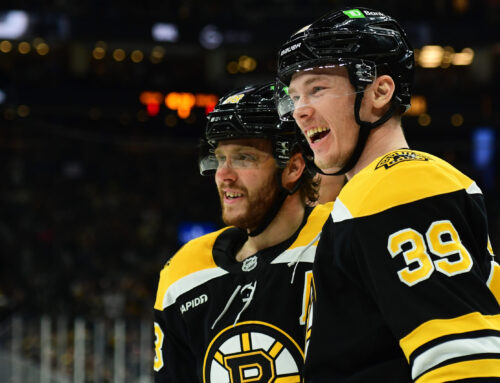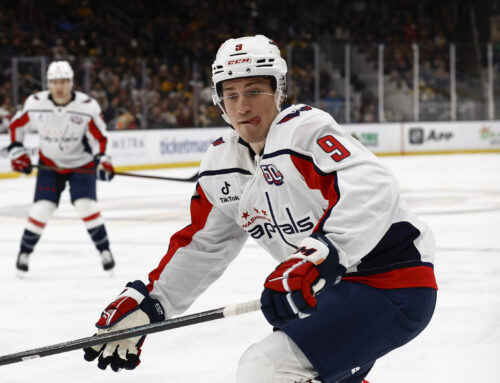In this week's Eastern Edge, we'll discuss power-play situations for the Islanders, Capitals and Canadiens. This will be the first of two articles about power plays in the East and we'll cover a few more teams next week. Anyone looking for some power-play data can head over to Frozen Tools. There are combinations, shots, percentages, and a whole lot more. That goes for more than just the power play, too, as there is something for everyone.
| Conference Rank (League Rank) | Team | PP Opportunities/ Games Played | PP% |
| 1 (2) | Toronto Maple Leafs | 2.94 | 29.7 |
| 2 (7) | New York Rangers | 2.88 | 25.3 |
| 3 (9) | Carolina Hurricanes | 3.13 | 23.7 |
| 4 (11) | Boston Bruins | 2.96 | 21.7 |
| 5 (14) | Buffalo Sabres | 2.52 | 19.3 |
| 6 (15) | Ottawa Senators | 3.24 | 19.2 |
| 7 (17) | New York Islanders | 2.68 | 18.7 |
| 8 (19) | Tampa Bay Lightning | 3.09 | 18.1 |
| T9 (T22) | Florida Panthers | 3.28 | 17.1 |
| T9 (T22) | Columbus Blue Jackets | 2.53 | 17.1 |
| 11 (26) | Philadelphia Flyers | 2.91 | 16.1 |
| 12 (27) | Pittsburgh Penguins | 2.84 | 15.9 |
| 13 (28) | Washington Capitals | 2.94 | 15 |
| T14 (T30) | Detroit Red Wings | 2.73 | 14.4 |
| T14 (T30) | New Jersey Devils | 2.73 | 14.4 |
| 16 (32) | Montréal Canadiens | 2.94 | 11 |
New York Islanders
While the overall numbers paint the Islanders as a middle-of-the-pack power-play team, there's a stark contrast between their early and recent performances. New York had the league's worst power play during the first two months of the season, converting on just 10% of their chances. However, they've turned things around recently, capitalizing on 35% of their opportunities since the beginning of December. To provide some perspective, only the Leafs (41.4%) and Hurricanes (37%) have been better with the man advantage this past month.
I'd say there are two main catalysts behind New York's improved power play, the first of which is Oliver Wahlstrom. When the Isles PP was struggling during those first two months of the season, Wahlstrom skated on the second unit and held a 42% share of New York's total time with the man advantage. Since things turned around in December, he's been a prominent piece of the top unit, seeing 64% of the team's total PP time. Wahlstrom posted five power-play points in nine appearances during the month of December.
The other catalyst for New York's improved power-play has been more ice time for the top unit. Early in the season, the team's two units saw an even split of PP time, but it's been more of a 65/35 split since the beginning of December. In past years, the Isles had a reputation of splitting time evenly between their power-play units. As such, you couldn't expect high levels of power-play production from any of the team's skaters. That seems to be changing now, and guys like Wahlstrom, Noah Dobson and Mathew Barzal stand to benefit from this new dynamic.
Washington Capitals
Over the past few years, I've learned that three things are certain in life: death, taxes and the Capitals having a good power play. You can understand why my outlook on life has been turned upside down this year with one of my most sacred beliefs falling apart. The Capitals have struggled with the man advantage this season, scoring on just 15% of their chances so far. During the first two months of the campaign, they were clicking at a respectable 18%. However, things have been bleak since the beginning of December, with the team scoring on just two of their 29 chances, for a 7% success rate.
Alex Ovechkin leads the league with a 95% share of his team's total power-play time. Considering the high volume of ice time, his production with the man advantage has been pretty underwhelming this year. After tallying three power-play points in his season debut, Ovi has just eight points with the man advantage in his last 33 appearances.
Injuries have limited Nicklas Backstrom to just three games this season, but he's still managed two power-play points. Remember how I said Washington had just two power-play goals in the month of December? Well, Backstrom factored in on both of them. I think his absence has a greater effect on the Capitals' power play than most people realize. When everyone's healthy, Washington's top unit likely features Ovechkin and Backstrom alongside Evgeny Kuznetsov, John Carlson and T.J. Oshie. The five players have shown great chemistry together in the past as each excels in his respective role. With Backstrom missing for most of the season, that chemistry has been thrown off as some guys have to shift around and take on roles that may not be optimal for them. Although Backstrom is currently sidelined with a non-COVID illness, it sounds like he's recovered from the more serious hip injury which kept him out for most of the year. It's hard to count on a healthy lineup during a global pandemic, but if Backstrom and the Caps can avoid injuries and quarantine in the second half, the team's power play should bounce back from a rough December.
Montreal Canadiens
Heading into the season, I confidently stated that Montreal had all the tools to ice an above-average power play. The way I saw it, they had elite shooters in Cole Caufield and Mike Hoffman, good playmakers with formidable shots in Nick Suzuki and Jonathan Drouin, a strong net front presence in Brendan Gallagher and a competent quarterback in Jeff Petry. There had to be a winning combination in there somewhere, right? Well, this season has been a comedy of errors for the Montreal Canadiens and the power play is no exception. They sit at the bottom of the league with a conversion rate of 11%, looking lost on most of their opportunities.
I'd say one of their biggest issues is that Petry looks like a shell of his former self. He's exhibited questionable decision making, forcing low-quality shots when teammates are wide open. Petry's skated over 60 minutes with the man advantage this year but doesn't have a single point to show for it. Chris Wideman has shown flashes of being a competent power-play quarterback, but his defensive lapses and overall inconsistency make it hard to trust him with a prominent role long term. For what it's worth, Wideman leads the team's defensemen with a whopping three power-play points in 22 games.
I'm cautiously optimistic about Montreal's long-term power play potential because I believe Suzuki and Caufield are a dynamic duo you can build around, but the team's rest of season outlook isn't so rosy. With a 7-23-4 record and a laundry list of long-term injuries to key players, I don't see their power play – or season in general, turning around any time soon. Expect them to continue experimenting with new combinations and testing out different players on the PP as the season progresses.





 TOR
TOR FLA
FLA VGK
VGK EDM
EDM DAL
DAL MIN
MIN CBJ
CBJ CAR
CAR WPG
WPG WSH
WSH DET
DET
